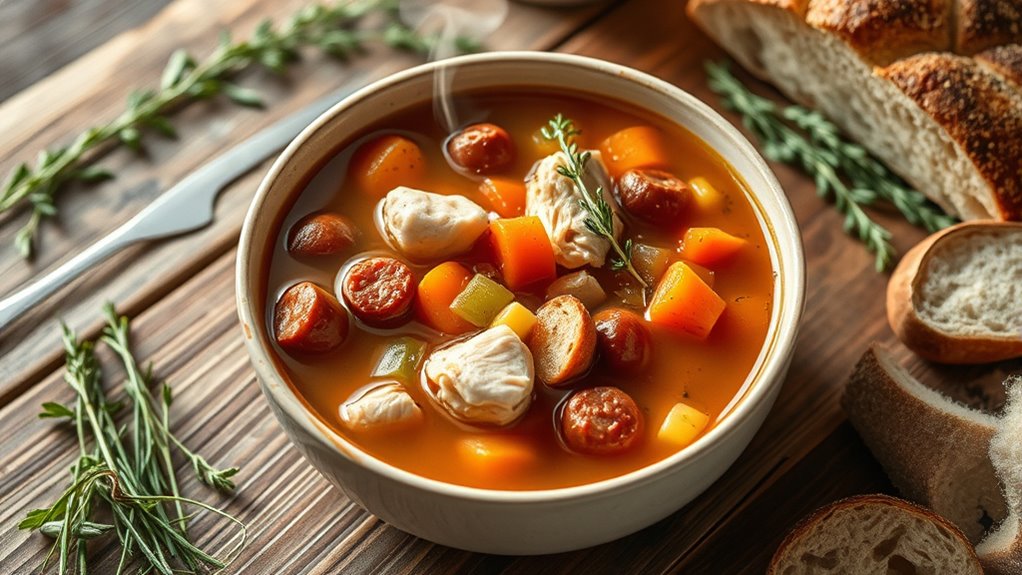A comforting bowl of chicken and sausage soup starts with searing the sausage to deepen its spice and adding chicken that browns in flavorful fat. You’ll sweat onions and garlic until they glow, then simmer with carrots, celery, potatoes, and rich broth until everything drinks in the warmth. Cream or a splash of dairy adds velvety depth, while greens brighten the finish. Want more tips and variations to perfect your pot? There’s more to explore.
Ingredients and Quantity
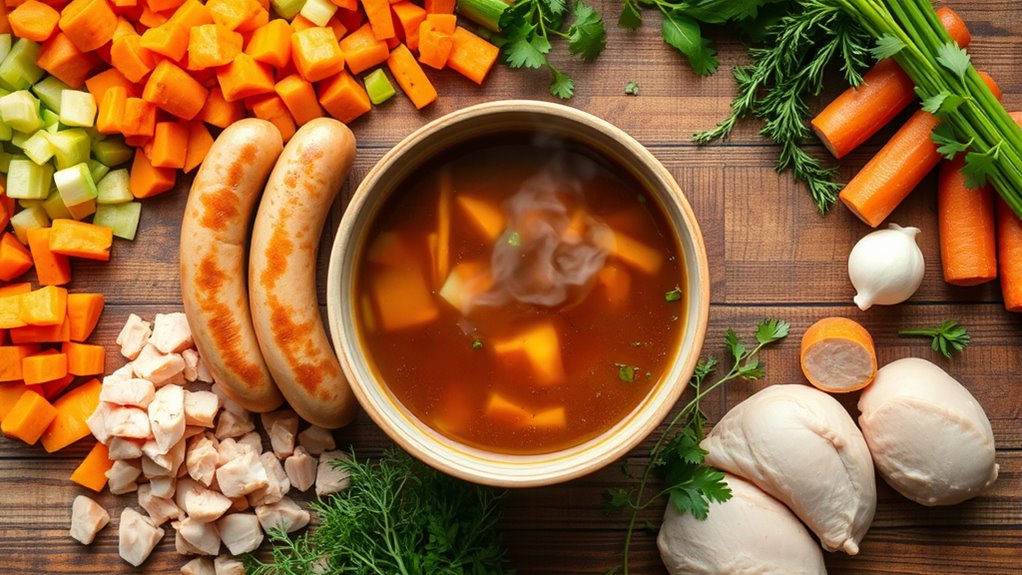
To make chicken and sausage soup, gather a hearty lineup: tender chicken, smoked sausage, onions, garlic, carrots, celery, potatoes, and leafy greens, plus chicken broth and a splash of cream. You’ll notice seasonal ingredients shaping the base, and flavor variations arise from small swaps.
| Item | Quantity |
|---|---|
| Chicken (diced) | 2 cups |
| Sausage (sliced) | 1 cup |
| Aromatics (onion, garlic) | 1 cup + 2 cloves |
| Veggies (carrot, celery, potato) | 2 cups total |
Your pantry becomes a canvas: you can lean into bold or light notes, depending on what’s in season, without losing heart. The blend stays vibrant, inviting, and free to roam, with crisp greens lifting the soup at the finish.
Preparations
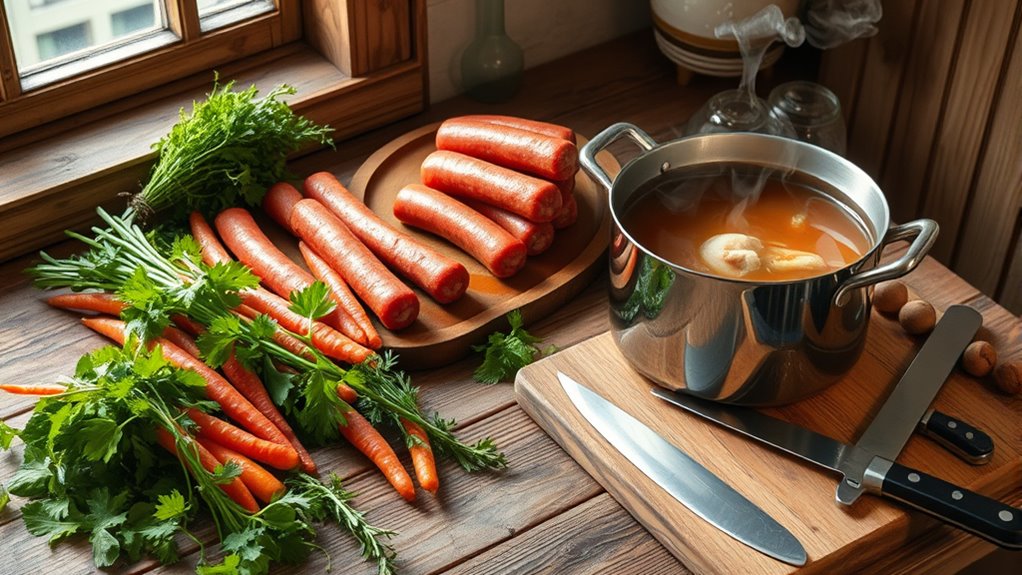
Gather your ingredients and set the stage: pat the chicken dry, slice the sausage into bite-sized rounds, and chop onions, garlic, carrots, celery, and potatoes so everything is within arm’s reach. In preparations, you’ll frame purpose with calm, efficient moves. You’ll sear sausage for depth, then sweat aromatics to coax sweetness from onions and garlic. Simmer bones or stock to release body and richness, watching foam rise then recede. Stir in diced veggies, greens as you like, and let flavors mingle through steady heat. Maintain a rhythmic tempo, honoring your freedom to adjust salt, pepper, and herbs. Explore soup variations by varying broths, adding tomatoes or corn, and testing spices. Mastery comes with practice, technique, and a confident, deliberate pace.
Kitchen tools or Kitchenware Required
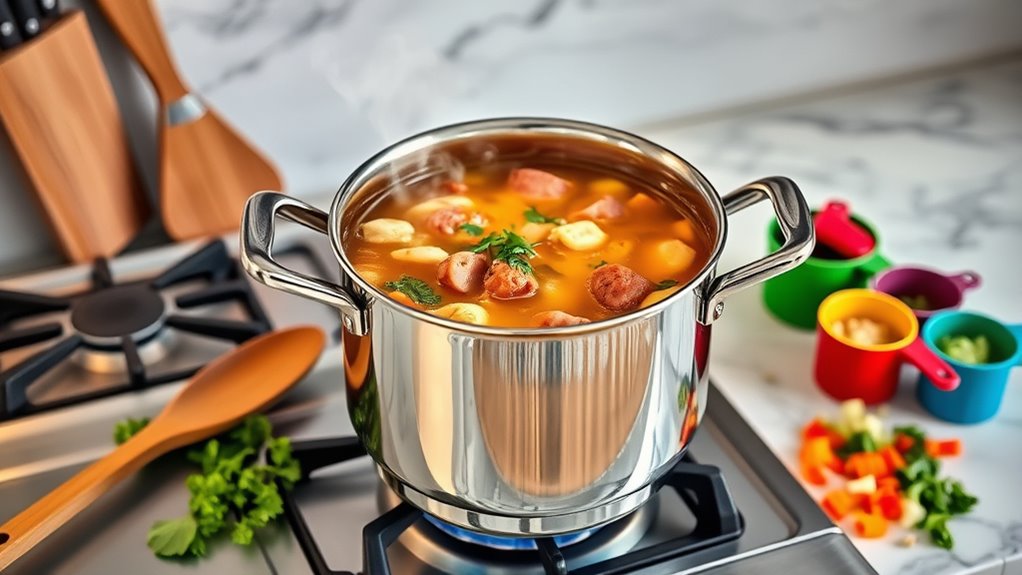
Even with a simple setup, you’ll want a handful of reliable tools that keep the process smooth: a sturdy stockpot or Dutch oven for simmering, a wide skillet for browning, and a sharp chef’s knife for clean cuts. Beyond those basics, a soup ladle and cutting board become your trusted companions, turning messy moments into confident control. You crave freedom in the kitchen, so choose gear that feels balanced in your grip and easy to clean. A roomy ladle invites you to taste often, while a stable cutting board protects your hands and the flavors you’re shaping. Ready, you plunge in, guided by tactile satisfaction and the scent of simmering promise.
| Tool | Purpose |
|---|---|
| Soup ladle | Serve and skim |
| Cutting board | Prep safely |
How to Cook
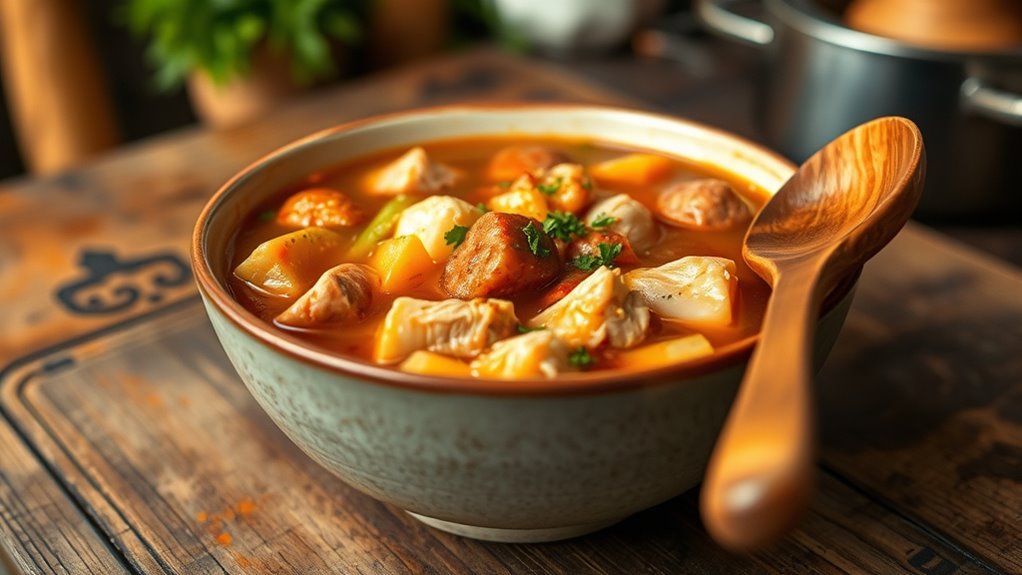
- Gather all necessary tools and ingredients for the chicken and sausage soup.
- Start by heating the pan to a medium-high temperature to sizzle the meat.
- Add the chicken and sausage, allowing them to sear quickly for color and to release aromatic steam.
- Maintain steady heat to let the aromas develop without rushing the cooking process.
- Once seared, reduce the heat to allow the chicken and sausage to simmer patiently until tender.
- Stir in chopped onions, minced garlic, and herbs, blending the flavors together.
- Taste the soup periodically, adjusting seasoning with salt, a touch of acidity, and a hint of sweetness to achieve balance.
- Allow the broth to absorb the flavors as the vegetables soften, thickening the soup into a comforting, rustic dish.
- Serve the soup boldly, appreciating the rich, savory notes developed throughout the cooking process.
How to Serve

When serving chicken and sausage soup, ladle it steaming into warm bowls and let the aroma drift up with every bite. You’ll savor the first inhale before a single sip, notes of simmered onions, herbs, and smoky sausage mingling with tender chicken. Keep the broth bright with a squeeze of lemon, a nod to brightness amid richness. For garnishing options, dust with chopped parsley, a swirl of cream, or a pinch of red pepper flakes for a gentle kick. Pair with crusty bread or cornbread to soak up every last drop. Serving suggestions: present bowls with a simple linen napkin, invite conversation, and let the steam carry your freedom to linger at the table. Enjoy, share, and savor the moment.
Tips
Here are some practical tips to elevate your chicken and sausage soup, building on the comforting notes from serving it. You’ll sharpen flavor with smart spice combinations, layering heat, earth, and brightness in small, deliberate pinches. Toasting sausage and aromatics first releases fats and aromas, guiding the simmer toward depth. Use cooking techniques like gentle simmering for tenderness and a quick finish of lemon zest or fresh herbs to wake the palate. Balance richness with a splash of white wine or a touch of apple cider for cohesion. Taste as you go, adjusting salt and acidity to your preference. Finish with a drizzle of olive oil and a final herb scatter for a bright, freeing aroma that lingers.
Food Value and Benefit
The chicken and sausage soup offers a well-rounded nutritional profile, combining protein, healthy fats, and a variety of vegetables in a warm, satisfying meal. This dish provides essential vitamins and minerals while promoting overall health and wellness.
The soup blends protein, healthy fats, and vegetables into a nourishing, satisfying meal.
Benefits of eating this chicken and sausage soup include:
- High-quality protein from chicken supports muscle maintenance and repair.
- Healthy fats from sausage enhance satiety and provide energy.
- Vegetables add dietary fiber, aiding digestion and promoting gut health.
- Rich in vitamins A, C, and K from vegetables, which support immune function, skin health, and blood clotting.
- Contains minerals such as iron, potassium, and zinc that contribute to oxygen transport, electrolyte balance, and immune defense.
- Balanced macronutrients help sustain steady energy levels and support cognitive focus.
- Quick and restorative meal option that supports everyday wellness without compromising flavor or freedom in your diet.
Frequently Asked Questions
Can I Freeze This Soup for Later Meals?
Yes, you can freeze this soup for later meals. You’ll love its silky broth and tender chunks. Use freezing techniques that protect texture, then try gentle reheating methods to preserve scent, flavor, and that freeing, comforting mouthfeel.
Which Sausage Types Work Best With Chicken?
Savor the sizzle: you’ll want Italian sausage, Andouille, or spicy chicken sausage for bold contrast, with each adding depth. You’ll feel heat, smoke, and herbs lift the broth, while spicy sausage sharpens the finish for freedom-loving cooks.
Can I Make This Dairy-Free or Gluten-Free?
Yes—you can make it dairy-free and gluten-free. You’ll notice rich dairy substitutes and gluten free options, plus bright aromatics, comforting heat, and creamy texture from coconut milk or almond cream, all aligning with your freedom-loving palate.
How Long Will Leftovers Stay Safe in the Fridge?
Leftover storage for soup safety: refrigerate promptly, and you’ll stay safe for 3–4 days. Feel the chill, savor the aroma, reheat thoroughly, and trust your senses for any off-notes before you dive back in.
Can I Add Vegetables Like Spinach or Kale?
Yes, you can add spinach or kale, mixing in near the end for bright greens and tender texture. You’ll taste leafy freshness while preserving nutritional benefits; consider sautéing briefly, then stirring in for vibrant color and varied cooking methods.
